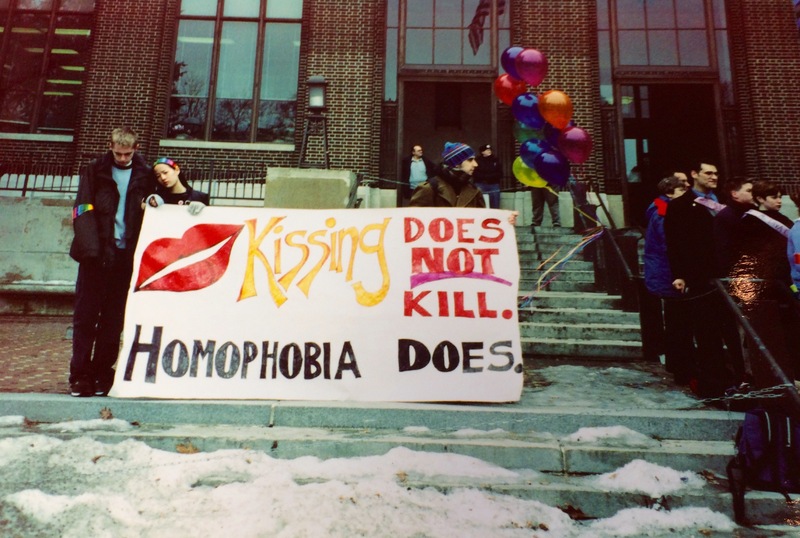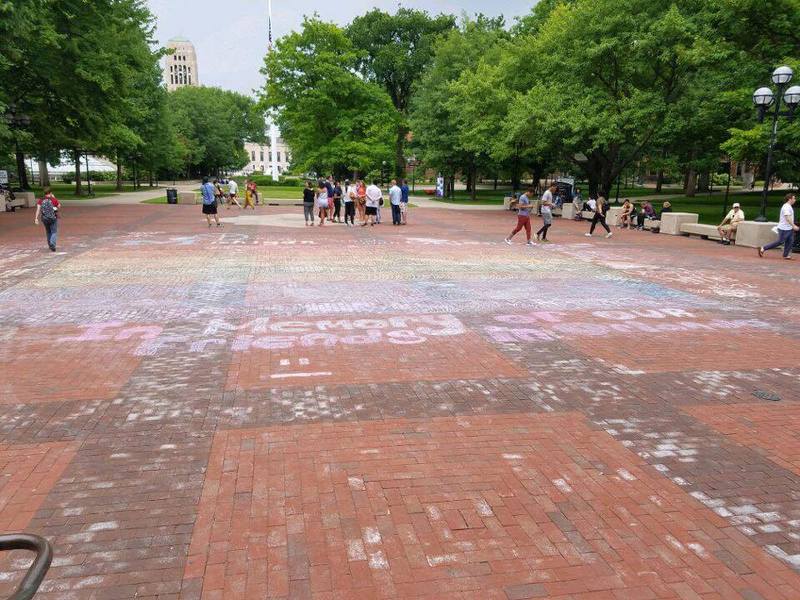Wesleyan’s Queer Protest Past into the Present
Queer History at Wesleyan
Queer history at Wesleyan University begins in 1975 with the creation of the first gay student organization. Prior to this there was a reprint in the Wesleyan Argus of an essay written by Stuart Byron ’63. This is the catalyst for the first gay student organization at Wesleyan. It discussed being gay at Wesleyan post-Stonewall Riots from 1969. The various essays and advertisements in The Wesleyan Argus after that note the struggle of trying to create and expand the first gay alliance for the University.
In the March 11, 1975 edition of The Wesleyan Argus, an advertisement was posted (shown on left) that let people know that there is a space for queer individuals to exist. My focus in this exhibit, then, shifts into a student group named QUICHE, or Queers United In Crushing Homophobia Everywhere. QUICHE’s formation comes from the veto vote for a California bill titled AB101, which would have made it illegal to discriminate based on sexual orientation. I examine the ways that groups like QUICHE have been catalysts for change on Wesleyan’s campus, in terms of the gay liberation movement. Wesleyan’s queer radical culture begins in the 1990s. Various homophobic attacks lead to QUICHE creating a massive postering event. QUICHE’s postering leads to prosecution from the state attorney.
QUICHE’s postering occurred overnight in 1991. The posters filled campus on the sidewalks, walls, among other places. The posters were rather sexually explicit, including phrases such as, “I fuck girls. I fuck boys. Deal with it.” At the time, even though it was about 16 years after the inception of the Gay Activist Alliance, and about 22 years since the Stonewall Riots, queer content was still scrutinized on campus and generally across the country. Because of this postering, there was persecution from the Connecticut State Attorney, amongst Wesleyan’s own public safety. The community also expressed concern with the explicit postering that occurred overnight. One Public Safety supervisor took action and removed about 600 of the sexually explicit posters, which frustrated QUICHE. QUICHE then demanded a reimbursement for printing costs for the removal of the posters by the Public Safety Supervisor.
The New Millennium / A Queer Kiss-In
The protests by queer organizations were not limited to the 1900s nor to just postering on campus. In the new millennium, the fight from queer liberation shifted to include academia at Wesleyan. Queer studies did not exist at Wesleyan prior. In 2001, there was an event called a “queer kiss-in”. Essentially, queer students protested via kissing to get a queer studies program created at Wesleyan. The administration at Wesleyan had ignored and/or denied request for queer studies programs prior to this year. They requested for three years before the kiss-in happened. They were requesting faculty for the program, specifically tenure-track faculty and a major. Students noted that colleges and universities, such as Brown, Columbia, Yale, etc. had queer studies programs. The queer kiss-in occurred in the admissions building.
Protest and Chalking at Wesleyan
Chalking has been a powerful form of activism for Wesleyan students. What is chalking? Chalking is using chalk to write various messages and phrases onto a surface, primarily the sidewalk, to talk about a specific issue on campus. Items in the physical exhibit contain news clippings from an external publisher titled “Queer chalking don’t corrupt kids.” A Wesleyan Argus edition from October 14, 1998 discusses a specific queer chalking event. This queer chalking was for the Wesleyan community to honor National Coming Out Day. There were three students that found the chalking to be “obscene” and decided to erase the chalkings. The newspaper does state that this time it was students and not physical plant who was erasing the chalking. In “An Apology is in Order”, written by Michael Polson, he notes, “They can’t deal with what defines Queerness: sex. And it is sex that differentiates between Queer and straight people. The rest is just social noise. Gay men can be campy, bitchy queens and lesbians can be leather-clad die-hard dykes, and thats o.k.” There were instances that the administration ordered chalkings to be erased by Physical Plant, and this still occurs now.



Cornell’s Influence and Radical Protests at Other Universities
In 1965, 4 years before the Stonewall Riots, a Columbia University student named Stephen Donaldson decided to create a student version of the Mattachine Society called Student Homophile League. Although it was rather difficult for Columbia to grant a charter to this group, they eventually did in 1967. It was mostly underground before then. In 1968, Donaldson gave a Student Homophile League charter to Jearld Moldenhauer at Cornell University. The path to a more militant movement begins at Cornell University with the second event that SHL hosts. The Cornell SHL invited David Burak to speak, who was previously banned for attempts at seizing the microphone at commencement. In an article written by Brett Beemyn, it states,” In announcing the event, the league also proclaimed its own militant position: ” We planned this meeting with full awareness and in protest of the court injunction against Dave’s appearing on campus. If the university wants an open campus, it can’t close it to anyone. An open campus does not mean letting Dow Chemical on and keeping Burak off.” Various institutions across the country have similar histories in terms of queer organizing on campus… As hoped, the event attracted large numbers of both gay students and SDS members and helped convince what Kelly calls “the Macho [L]eft” that gay people were part of the movement and could be just as radical.”
Moreover, Beemyn notes, ” Cornell’s SHL dropped their use of pseudonyms, held open meetings, and dances, and began to speak publicly about their sense of pride in being gay. By discussing their lives in front of various audiences and countering the stereotypes of lesbians, gay men, and bisexuals, they and subsequent groups at other colleges helped make it possible for many more gay people to accept themselves and come out. In no small way, these efforts contributed to the development of a large-scale political movement in the years that followed.”
David A. Reichard discusses Beemyn’s history of the SHL, but also states, “Given these conditions, it is perhaps not surprising that after the Stonewall rebellion of 1969, gay and lesbian student organizations on college campuses in the United States “grew like weeds in a vacant lot,”as legal scholar William Eskridge Jr. has asserted.” Reichard also notes, “Yet, gay, lesbian, and bisexual students attempting to organize on campus faced numerous challenges, including fear of coming out publicly and outright resistance from members of the campus community, alumni, or community member,” Reichard goes on to discuss a legal challenge that Sacramento State College’s(SSC) Society for Homosexual Freedom faced on whether SSC could deny formal recognition. The court ruled in favor of the group. Reichard’s inquiries build upon Beemyn’s discussions on the first gay groups on campus and the creation of groups on campuses following Stonewall. Reichard, however, delves into the legal obstacles college groups faced.
This ultimately goes back to Wesleyan’s first gay group on campus in 1975, which largely began anonymous. From here, we move on to Wesleyan’s post-Stonewall Riot history in radical organizing by queer organizations on campus. Beemyn helps us understand how fundamental colleges and universities, and their students, were in the movement for queer rights.
At University of Michigan, we see an example of chalking used to remember victims of the mass shooting at Pulse night club. University of Michigan also had a queer kiss-in protest on its campus. Various types of protests and events resonate nationwide. Ultimately, these protests become forms of speaking out against homophobic acts and seeking to create institutional change with its intensity.


Why study the growth of queer organizations at Wesleyan University?
In the spring semester of my freshman year I took a course titled “LGBT History in the United States: 1940-Present”, which discussed, as the title says, queer history in the United States. In spring of my junior year, I took an advanced version titled “No Day but Today: United States Queer History“. It was in this second version of the course that we visited the Wesleyan University Special Collections and Archives. Up until that point, I did not know that our collections contained a major repository for queer history within Wesleyan’s campus but also nationally. It was like a treasure trove of a dense and rich queer history. It was not a collection that was widely advertised but existed within our archives. This semester, with this public history course, I revisited the queer archives collection and stumbled upon QUICHE. I quickly realized that Wesleyan’s queer organizing was as it is now. It had a vibrant history of protest art and protests generally. It was a queer radical form of protest that I was fascinated by. Even in my queer history classes, we did not talk much about Wesleyan’s queer history. The trajectory that begins post-Stonewall into the new millennium by queer Wesleyan students was a trajectory I really wanted to hone in and present to the greater community and student body. From researching the archives and other texts on queer organizing on other campuses, I unearthed this rich history that I never knew about. I wanted others to feel enlightened by this history that has made Wesleyan more of a sanctuary for queer people. Wesleyan has become a home for me and is a sanctuary for many. And still, we protest.
Sources
Photos
- University of Michigan, Queer on Campus: 1970s to Present, https://michiganintheworld.history.lsa.umich.edu/dangerousexperiment/exhibits/show/studentlife/queer-on-campus
- Wesleyan 75% Queer, 25% Frosh Zine, Wesleyan Special Collections and Archives, Queer Issues, Vertical File 01-148
- “The Fight for Queer Studies at Wesleyan” Poster, Wesleyan Special Collections and Archives, Queer Studies – Mobilizations/ Protests, Box 3 Folder 7
- “Why are all these people engaged in “queer” kissing all over campus?” Flyer, Wesleyan Special Collections and Archives, Queer Studies – Mobilizations/ Protests, Box 3 Folder 7
- “Lesbian Lodge” Queer kiss-in Flyer, Wesleyan Special Collections and Archives, Queer Studies – Mobilizations/ Protests, Box 3 Folder 7
Secondary Sources
- Public Safety Supervisor to be Disciplined for Censoring Posters, The Wesleyan Argus, October 8, 1991, https://digitalcollections.wesleyan.edu/islandora/wesleyan-argus-volume-127-number-10-october-8-1991
- Queer Chalkings Erased, The Wesleyan Argus, October 14, 1998, https://digitalcollections.wesleyan.edu/islandora/wesleyan-argus-volume-134-number-11-october-14-1998
- Growing Up Gay At Wesleyan; Where Were You In ’62?, The Wesleyan Argus, February 26, 1974, https://digitalcollections.wesleyan.edu/islandora/wesleyan-argus-volume-107-number-32-february-26-1974
- GAA Advertisement, The Wesleyan Argus, March 11, 1975, https://digitalcollections.wesleyan.edu/islandora/wesleyan-argus-volume-108-number-39-march-11-1975
- Daring to Experiment: Wesleyan’s Queer History 1974-2000, Wesleyan University, https://www.wesleyan.edu/queer/history.html#:~:text=As%20a%20few%20people%20began,themselves%20the%20Wesleyan%20Gay%20Group.
- Queer on Campus: 1970s to Present, https://michiganintheworld.history.lsa.umich.edu/dangerousexperiment/exhibits/show/studentlife/queer-on-campus
- Beemyn, Brett. “The Silence Is Broken: A History of the First Lesbian, Gay, and Bisexual College Student Groups.” Journal of the History of Sexuality, vol. 12, no. 2, 2003, pp. 205–23. JSTOR, http://www.jstor.org/stable/3704612.
- REICHARD, DAVID A. “‘We Can’t Hide and They Are Wrong’: The Society for Homosexual Freedom and the Struggle for Recognition at Sacramento State College, 1969–1971.” Law and History Review, vol. 28, no. 3, 2010, pp. 629–74. JSTOR, http://www.jstor.org/stable/25701145.



